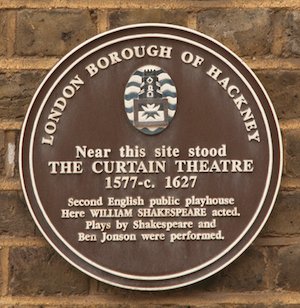‘Playing the Curtain’ with Dr. Lucy Munro
Talk by Dr Lucy Munro on the Curtain Theatre
13 May 2016, Museum of London Archaeology, Mortimer Wheeler House, London
Review by Gemma Miller, PhD Candidate, English, KCL

Plaque indicating where the Curtain once stood
Amid the plethora of events marking the 400th anniversary of Shakespeare’s death, it is easy to forget that 2016 is also a significant year in the history of the Curtain Theatre. Built in 1576, it was one of the first permanent theatres to be constructed just outside the City of London in the liberties of Halliwell/Holywell in Shoreditch, London, and staged a number of key early modern plays between the 1570s and 1624, when it closed. Somewhat confusingly, it was called the ‘Curtain’ because it was located near a plot of land called Curtain Close (named after a ‘curtain wall’ that surrounded a priory), and not due to any semantic connection to the stage curtain seen in modern theatres. The theatre’s remains were discovered in 2012 and, as excavations develop, important discoveries are being made about this historical building that are making academics change their assumptions about early modern theatre. ‘Narratives are being adjusted at this moment’, explained Dr. Lucy Munro, ‘with ongoing archaeological progress’. You may not be as familiar with the Curtain Theatre as with the more celebrated Globe or Swan theatres, but as this talk demonstrated, it was a vital landmark in the development of our rich theatrical culture and the inspiration for many of the plays we still enjoy today.
So, what do we know about plays staged at the Curtain? We know, for example, that The Chamberlain’s Men, Shakespeare’s playing company that was to become The King’s Men with the accession of King James I in 1603, used the Curtain Theatre between 1598-99 following a disagreement with their landlord at the nearby Theatre. We know, also, that Romeo and Juliet was staged there in 1596 and that there is a strong possibility that both Much Ado About Nothing and Henry V premiered at the Curtain in the late 1590s. As Dr. Munro explained, there is some controversy about when the prologue to Henry V was first included. In this highly metatheatrical soliloquy, references to ‘this wooden O’ and ‘the Girdle of these Walls’ are now accepted to be explicit references to the Globe Theatre. However, the Chorus was not included in the 1599 quarto, making its first appearance in print in the 1623 First Folio. It is not fanciful therefore to deduce that these references were added after The Chamberlain’s Men moved from the Curtain Theatre to the Globe on London’s Southbank. If this assumption is correct, it provides a fascinating insight into the ways in which Elizabethan playing companies adapted their texts to accommodate the shifting environments, tastes and contexts of their audiences.
Dr. Munro gave us a fascinating insight into the canonical Shakespearean and Jonsonian plays that may (almost certainly) have been staged at the Curtain Theatre. However, in true playwriting style, she saved the most entertaining nuggets for her finale, taking the audience through imagined stagings of two lesser-known comedies with connections to the Curtain: the lost play Cloth Breeches and Velvet Hose, based on Robert Greene’s 1592 narrative, A quip for an upstart courtier, or A quaint dispute between velvet breeches and cloth-breeches, and the anonymous No-body and Some-body. For those interested in exploring these sartorially-themed satires further, and I urge you to do so, links are provided below.

